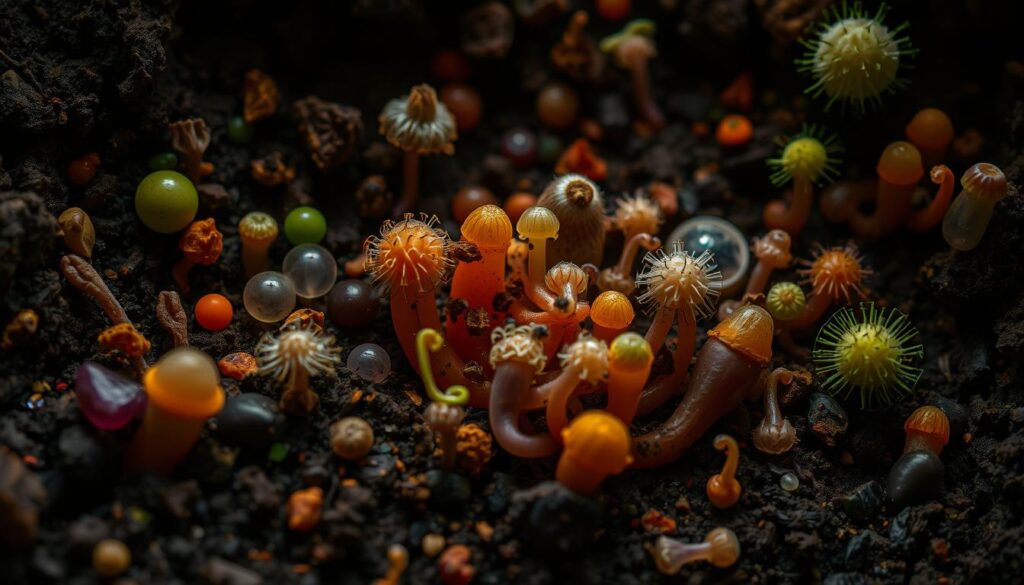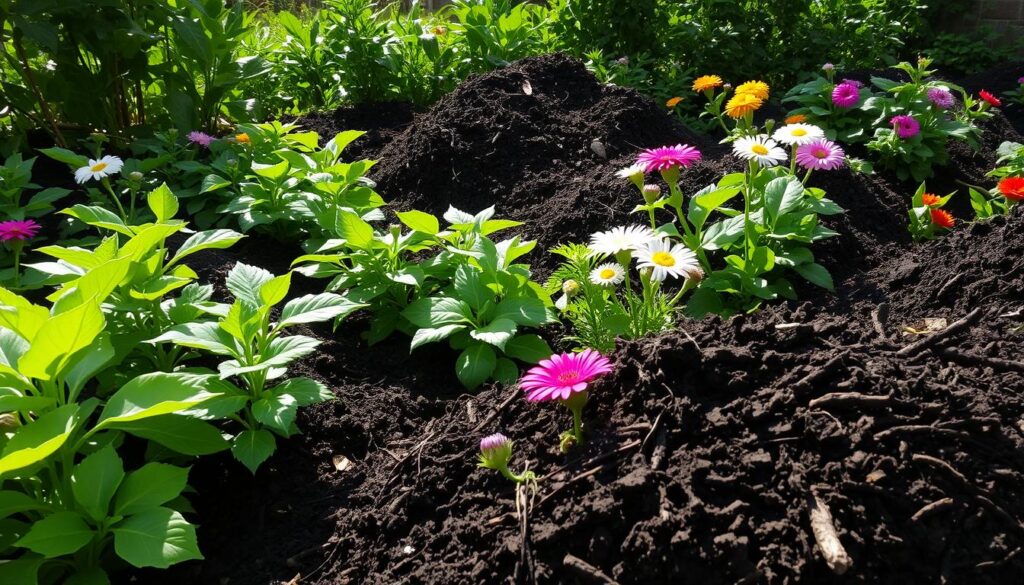I’ve seen how composting can change a garden. At first, my plants didn’t do well. But then I started making my own compost. It’s been amazing to see my plants grow strong and healthy.
This guide will cover the basics of beginner’s guide to composting. We’ll look at the science and the benefits for organic gardening. It doesn’t matter if you’re new to gardening or already composting at home. This guide will help you make your garden a beautiful place.
Key Takeaways
- Composting is a cost-effective and eco-friendly way to turn food scraps and yard waste into nutrient-rich soil for your garden.
- Compost helps to improve soil structure, moisture retention, and the growth of beneficial microorganisms essential for plant health.
- Composting can significantly reduce your household’s waste and your reliance on synthetic fertilizers.
- Different composting methods, such as traditional piles, bins, and worm composting, can be tailored to your available space and waste volume.
- Incorporating compost into your gardening practices can lead to healthier, more vibrant plants with increased yields.
What is Composting and Why is it Important?
Composting turns organic waste like food scraps and yard trimmings into a nutrient-rich soil amendment. This process helps reduce landfill waste. It also boosts plant health and protects the environment.
Understanding the Composting Process
The composting process breaks down organic matter with the help of microorganisms like bacteria and fungi. These microbes turn the materials into a dark, crumbly, earthy-smelling substance. The success of composting depends on balancing carbon-rich “browns” with nitrogen-rich “greens.”
Benefits of Composting for Plant Health
- Compost enhances soil structure, texture, and water retention, creating a better growing space for plants.
- It provides vital nutrients like nitrogen, phosphorus, and potassium, essential for plant growth.
- Compost fights plant diseases and pests by fostering beneficial microorganisms in the soil.
- It reduces the need for harmful synthetic fertilizers, protecting the environment and preventing water pollution.
Composting is key to a sustainable gardening and agricultural approach. It turns waste into a valuable soil amendment. This not only helps your plants but also benefits the environment.
“Compost is the single most important soil amendment for growing healthy, productive plants.” – Rodale Institute
How to Get Started with Composting
Composting is easy and rewarding. It turns your waste into rich soil for your garden. You need to pick the right method and gather materials. The goal is to mix “brown” and “green” materials just right.
Choosing a Compost Bin or Pile
First, decide between a compost bin or an open pile. Bins are good for small spaces, keeping waste in and smells out. For bigger yards, an open pile might be better. Think about your yard size, waste volume, and what you like.
Essential Composting Materials
- Carbon-rich “brown” materials: Shredded paper, cardboard, dry leaves, straw, sawdust, or wood chips.
- Nitrogen-rich “green” materials: Fruit and vegetable scraps, coffee grounds, eggshells, grass clippings, and manure.
Layer these materials in your bin or pile, aiming for a 3:1 brown to green ratio. This balance is key for the microorganisms that break down waste.
Keep your pile moist but not too wet. Turn it often for even decomposition. With the right mix and care, you’ll make great compost for your plants.
Compostable and Non-Compostable Items
Building a great compost pile starts with knowing what to add and what to skip. A good mix of materials turns kitchen and yard waste into rich soil. This soil is perfect for your organic gardening projects.
Kitchen Scraps: What to Include
- Fruit and vegetable peels, cores, and scraps
- Coffee grounds and filters
- Eggshells
- Bread, pasta, and cereal
- Tea bags and leaves
- Shredded paper and cardboard
Yard Waste: What Works Best
- Leaves, twigs, and branches (chopped or shredded)
- Grass clippings
- Spent flowers and plants
- Hay or straw
Items to Avoid in Your Compost
Not everything can go into your compost pile. Some items are best left out. These include:
- Meat, poultry, and fish scraps (attract pests and create odors)
- Dairy products (attract pests and create odors)
- Oils, fats, and grease (slow down decomposition)
- Pet waste (may contain harmful bacteria)
- Diseased plants (can spread diseases)
- Weeds with seeds (can spread weeds in your garden)
By sticking to these rules, you can make a compost system that turns waste into a gardening goldmine. This is great for your organic gardening projects.
The Science Behind Composting
Composting turns ordinary waste into a rich soil amendment. At its core are the microorganisms that break down waste. These tiny creatures, like bacteria and fungi, are key to the composting process.
Microorganisms: The Unsung Heroes
These tiny beings eat the materials in your compost, releasing heat. This heat helps kill off harmful pathogens and weed seeds. It makes the compost safe for your garden.
The Role of Oxygen and Moisture
Oxygen and moisture are vital for the microorganisms. They need air and the right amount of water to work well. Turning the compost pile helps keep it aerated. Keeping it moist but not soggy is also important.
By understanding composting, you can create the best environment for these microorganisms. They turn your waste into a dark, crumbly humus. This humus will feed your plants and improve your soil.

“Composting is the ultimate recycling, transforming waste into a valuable resource for the garden.”
| Composting Essentials | Ideal Conditions |
|---|---|
| Temperature | 130-150°F |
| Oxygen Levels | 10-15% |
| Moisture Content | 55-65% |
Maintaining Your Compost Pile
Keeping your compost pile healthy is key to turning kitchen scraps and yard waste into rich soil. Regular care helps with decomposition and avoids common problems.
Turning Your Compost: When and How
Turning your compost regularly is vital for aeration and even decomposition. Turn it every 2-4 weeks, depending on its size. Use a pitchfork or compost aerator to fluff it up.
This action introduces oxygen, which is essential for breaking down organic matter. It helps the microorganisms do their job.
Troubleshooting Common Issues
- Odors: Unpleasant smells mean too much moisture or an unbalanced carbon-to-nitrogen ratio. Add dry leaves or shredded paper to absorb moisture and balance it out.
- Slow Decomposition: If it’s slow, turn the pile more often to add oxygen. Adding soil or finished compost can also help.
- Pests: Don’t add meat, dairy, or pet waste to avoid pests. Keep your pile enclosed to keep animals out.
By watching for problems and fixing them quickly, you can keep your compost pile healthy. This will give your plants the nutrient-rich soil they need to grow well.
Types of Composting Methods
There are many composting methods for different needs and spaces. From open-air piles to indoor techniques, the right method improves your compost quality.
Traditional Composting Techniques
Traditional composting uses open-air piles or bins. It’s a simple way to turn food scraps and yard waste into garden fertilizer. With the right mix of materials and care, it works well.
Vermicomposting with Worms
Vermicomposting uses worms to break down organic matter. These worms turn food scraps into a nutrient-rich compost called vermicast. It’s great for indoor or small-space gardening.
Bokashi Composting: Fermentation Method
Bokashi composting breaks down a wide range of materials, including meat and dairy. It uses special Bokashi bran to start fermentation. The compost can then be buried or added to a traditional pile.
| Composting Method | Key Features | Ideal for |
|---|---|---|
| Traditional Composting | Open-air pile or bin, balance of “brown” and “green” materials, aeration and moisture control | Outdoor gardening, larger scale composting |
| Vermicomposting | Utilizes earthworms to break down organic matter, suitable for indoor or small-space use | Indoor or small-space gardening, apartment dwellers |
| Bokashi Composting | Fermentation-based method, can handle a wider range of organic materials, including meat and dairy | Small-space composting, handling of food scraps |
Knowing the different composting methods helps gardeners and homeowners choose the best one. Whether it’s traditional piles, worm composting, or Bokashi, home composting is good for the environment and your plants.
Understanding Compost Maturity
Compost is key in organic gardening. Knowing when it’s ready is important. Finished compost is dark, crumbly, and smells earthy. It’s full of nutrients that help plants grow strong.
Signs of Finished Compost
Here’s how to know if your compost is ready:
- The original materials are gone, and it looks like soil.
- It smells rich and earthy, not bad.
- The pile’s warmness has faded, showing it’s done breaking down.
- It’s dark and crumbly, with a light, airy feel.
Using Finished Compost in Your Garden
When your compost is mature, it’s time to use it. Add it to your garden beds, pots, and lawn. It makes soil better, holds water, and helps plants grow. Using compost is a natural way to care for your garden.
| Compost Type | Key Benefits | Best Suited For |
|---|---|---|
| Peat-Free Compost | Eco-friendly, Promotes Soil Fertility | Vegetable Gardens, Flower Beds |
| Green Waste Compost | Affordable, Readily Available | Mulching, Soil Conditioning |
| Mushroom Compost | Improves Heavy Soils, Enriches Soil | Clay-Based Soils |
| Leaf Mould | Enhances Soil Structure, Retains Moisture | Sandy and Clay Soils |
| Manure-Based Compost | Nutrient-Rich, Promotes Fertility | Vegetable Gardens, Roses, Heavy Feeders |
Applying Compost to Your Plants
Composting turns waste into a soil amendment that’s full of nutrients. Once you’ve made your compost, it’s time to use it in your garden. There are many ways to apply compost, each with its own benefits.
Different Ways to Use Compost
- Mixing it into the soil: Add compost directly to the soil, either when preparing beds or around established plants. This improves soil structure, holds water better, and gives nutrients.
- Using it as a top dressing: Spread compost on the soil surface, around trees and shrubs. Do this at the start of the growing season or any time to feed the soil and control weeds.
- Creating compost tea: Soak finished compost in water to make a nutrient-rich “tea.” Use it as a foliar spray or soil drench to give plants an extra nutrient boost.
Timing Your Compost Application
When you apply compost is key for plant health. Apply it in the spring before planting or as a top dressing for established plants. This lets the nutrients reach the roots as plants grow. You can also apply compost in the fall to improve soil structure and fertility for the next season.
Using compost regularly will greatly benefit your garden. It improves soil structure, nutrient content, and water-holding capacity. This leads to healthier, more vibrant plants. Start composting and watch your organic garden flourish!

| Compost Type | Best Use |
|---|---|
| Multi-Purpose Compost | Versatile for seed sowing, potting, and container gardening |
| Seed Starting Compost | Promotes healthy root development and easy germination for seedlings |
| Organic Compost | Excellent for vegetable gardens and organic food production |
| Green Waste Compost | Great for mulching and improving soil in borders and flower beds |
| Mushroom Compost | Ideal for improving heavy soils like clay and enriching vegetable beds |
| Manure-Based Compost | Suitable for vegetable gardens and roses, providing balanced nutrients |
| Ericaceous Compost | Recommended for acid-loving plants like Rhododendrons and Azaleas |
| Fruit and Vegetable Compost | Great for vegetables and fruiting plants like Tomatoes and Strawberries |
| Tub and Basket Compost | Ideal for container plants like Geraniums and Petunias |
| Orchid Compost | Suitable for flowering plants like Roses, delivering high nitrogen and phosphorus |
| Rose, Tree & Shrub Compost | Recommended for shrubs and trees like Maple and Olive trees |
| Bulb Compost | Ideal for bulbs and perennials like Tulips and Iris, ensuring well-draining compost |
| Cactus Compost | Suitable for Succulents and Cacti like Aloe Vera and Jade Plant, providing excellent drainage |
Choosing the right compost for your plants is key. Match the compost type to your plants’ needs for the best results. Try different composts to find what works best for your composting tips and organic gardening practices.
Common Myths About Composting
Many people think composting is hard or smelly. But it’s actually simple and good for your plants and the planet. Let’s clear up some common myths about composting.
Debunking Popular Misconceptions
Some think composting is smelly and messy. But a well-kept compost pile or bin shouldn’t smell bad. By mixing the right materials and keeping it aerated and moist, you can avoid odors.
Another myth is that composting is only for rural areas. But, composting troubleshooting works in cities too. Even those with little space can compost using small bins or tumblers.
The Truth About Smelly Compost
If your compost smells, it means something’s off. It might be too wet, not enough air, or too much nitrogen. Fixing these issues can make your compost smell-free again.
Composting is natural and easy to manage. Don’t let myths stop you from trying it. Start composting today and enjoy its benefits!
Additional Resources for Composting Enthuisiasts
If you’re excited to learn more about composting, there are many resources out there. You can find books, online guides, and local workshops. These offer a wealth of knowledge to help you grow your gardening skills.
Books and Online Guides
For those who like to read, there are many books on composting. “The Vegetable Gardener’s Bible” by Edward C. Smith and “The Compost Accelerator” by Stu Campbell are great choices. They dive deep into composting science and techniques.
University extension services and gardening groups also have online guides. Rutgers University’s “Backyard Composting” is a great example. It covers a lot of composting topics.
Local Workshops and Community Programs
If you prefer learning by doing, check out local workshops and community programs. Many places, like gardening clubs and non-profits, offer these. They teach you how to compost, from building bins to using compost in your garden.
These events are a great way to meet others who love composting. You’ll find a supportive community of like-minded people.
FAQ
What is composting and why is it important?
Composting turns organic waste like food scraps and yard waste into nutrient-rich soil. It’s key because it cuts down waste, boosts soil health, and supports green living.
What are the benefits of composting?
Composting makes soil rich in nutrients, holds more moisture, and improves its texture. It also cuts down on carbon emissions by keeping organic waste out of landfills.
What can I compost at home?
You can compost kitchen scraps like fruit and veggie peels, eggshells, and coffee grounds. Yard waste like leaves and grass clippings are also good. But skip meat, dairy, and oily foods as they attract pests and slow down the process.
How do I maintain my compost pile?
Mix your compost materials regularly to speed up decomposition. Keep it moist but not soggy. Add soil or finished compost to introduce beneficial microbes. Watch for odors or slow decomposition and adjust as needed.
What are the different composting methods?
You can choose from several methods, like traditional piles or bins, worm composting, or Bokashi, which is great for small spaces or indoors.
How do I know when my compost is ready to use?
Ready compost is dark, crumbly, and smells earthy. It’s done when you can’t see the original materials. Use it in your garden, pots, or as a lawn dressing to enhance soil and plant health.
Are there any common myths about composting?
Yes, myths say composting is hard or smelly. But done right, compost shouldn’t smell bad. It’s a simple, rewarding practice, even in cities.


